Most bees play an important pollination role in the ecosystem. Even bees that don’t produce any honey have an important role in crops, fruit trees, and plants.
Various species of bees live either individual or social lives in the world. Many are shipped as pupa with expected benefits in pollination.
Not all bees are the same. Most are yellow and black but many can be green, black, or come in other color combinations.
Table of Contents
Bee size
Most bees have a size between 9 and 15mm. Queen bees tend to be larger, easily being seen in sizes of at least 20mm.
Bee color
Bees sometimes come in one dominant color. They come in brown, yellow, white, and black color combinations. They might also be primarily green or red.
Bee habitat
Bees live in wet or dry lands outdoors or in a domesticated environment. Dependent on pollen and nectar, bees are found in areas with plenty of vegetation.
Woodlands, meadows, wetlands, and even the tundra can be suitable habitats for various species of bees.
Types of Bees
The following species are common in North America and around the world.
1. Western Honey Bee

Western Honey Bees (Apis mellifera) are the most common types of honey bees in the world with a considerable presence on all continents.
The species is known to live in colonies that live on for years.
Bees of this genus prioritize the survival of the colony rather than individual survival.
These bees are led by a queen bee with full reproductive capacity and which is also larger than the other bees in the colony.
Worker female bees are the cast that supports the colony while male drones live to fertilize the new queen for the colony.
2. Common Eastern Bumble Bee

Some of the most common types of bumble bees are the Common Eastern Bumble bees (Bombus impatiens).
They dominate habitats such as Eastern parts of North America.
These bees have a considerable pollination role here. Common Eastern Bumble Bees nest in the ground.
While there’s no set pattern for the ground nest, these bees have a worker cast which ensures the irregularly-shaped in-ground nest is well-maintained.
Goldenrod and clovers are among some of the common plants these bees seek out pollen and nectar from.
3. Eastern Carpenter Bee

As the name implies, the Eastern Carpenter Bee (Xylocopa virginica) is a species that seeks out various types of wood as a nest.Eastern Carpenter Bee
These bees live under a colony, like other bees. A queen leads the colony but takes on multiple responsibilities including mating and maintaining the nest together with worker bees.
While the species has a worker cast, they do not store honey or pollen in the nest as honeybees. They bring it in on occasion, mainly to feed emerging young bees.
4. Brown-belted Bumble Bee

The Brown-belted Bumble Bee (Bombus griseocollis) has a considerable North American presence.
Seen in almost all states with a few Southeastern exceptions, this is a species of ground-nesting bees with a clear hierarchy.
For example, worker Brown-belted Bumble Bees have clear nest care tasks. They routinely use wax to repair or rebuild the underground nest.
Male Brown-belted Bumble bees have the role of mating with the queen.
5. American Bumble Bee

These types of bees (Bombus pensylvanicus) are a common sight across Eastern and Southeastern US habitats.
Living under colonies, they show a clear hierarchy under a large queen.
The American Bumble Bee queen is larger than other bees in the colony, with a size of up to 26mm.
Smaller female American Bumble Bees grow up to 19mm.
Fertilized and unfertilized eggs are laid in the nest of these bees. Only fertilized eggs may increase the population of females within the nest.
6. Two-spotted Bumble Bee

Some of the most prevalent and growing types of bumble bees in North America are the Two-spotted Bumble bees (Bombus bimaculatus).
Named after the yellow spots on a black body, these bees nest in the ground.
Unlike the deep nests of the Common Eastern Bumble Bee, the nests of the Two-spotted Bumble Bees are only a few inches deep.
Various types of flowers and trees are on the list of foods in the diet of the species. Willows and lilies of the valley-like zenobias are among the most common nectar and pollen sources for the Two-spotted Bumble bees.
7. Ligated Furrow Bee

A North American native, the Ligated Furrow Bee (Halictus ligatus) is an important pollinator.
This eusocial bee nests in well-Ligated Furrow Beesoils or decaying wood. It prefers soils clear of vegetation for its nests which are used year after year.
Queens lead the nest while worker bees gather pollen which they provision to young bees.
A preference for high-protein pollen is specific to the Ligated Furrow Bee.
High levels of aggression within the species are common for these bees, mainly to exert authority.
8. Yellow-faced Bumble Bee

These black bees (Bombus vosnesenskii) have yellow marks on their face and their hairy thorax.
Mostly seen on the US West Coast, the species nests in the ground.
A major pollinator role is attributed to the species, particularly in greenhouses. While a good pollinator, the bees face a diminished status in urban areas with a higher presence outside cities.
The diet of the species isn’t based on all types of plants with nectar, as with other bumble bees. They prefer lantana and asters alongside tomatoes in greenhouses.
9. Pure Gold-green Sweat Bee

These (Augochlora pura) are the most common bees in Eastern US woodlands. A metallic green color is characteristic of the species.
Both males and females nest in wood or the ground. They live individual lives without a hierarchy or a colony.
These bees also show high levels of aggression towards each other whenever they find their nests occupied.
Pure Gold-green Sweat Bees are pollinators of woodlands and the habitats closest to woodlands.
10. Bicolored Striped Sweat Bee

This species (Agapostemon virescens) has a green thorax and a black and white abdomen.
Alternating black and white stripes on the abdomen are dominating but some females may come in an all-green color.
A type of solitary bee, the Bicolored Striped Sweat Bee lives in individual nests made by females. On occasion, a nest might be shared by females, each with its own space.
They use these nests in the summer and as overwintering locations.
It feeds on multiple types of flowers such as asters and sunflowers.
Other types of common nectar-rich flowers such as goldenrod also attract these bees.
11. Two-spotted Longhorn Bee

Identified by its mostly black body, the Two-spotted Longhorn bee (Melissodes bimaculatus) is native to North America.
The species has a known pollination role on certain crops as well as for asters.
The bee is seen in the spring and summer months. It has an expanded dry land habitat next to woodlands or on crops.
Two-spotted Longhorn Bees collect pollen which is used to feed the newly-emerging bees of the species.
12. Black-tailed Bumble Bee

This mostly black species (Bombus melanopygus) is a common sight across Western North America.
Its highest numbers are seen across California and Oregon while the species has a noted presence North of Alaska.
It comes in a few morphs with black being the base color across all of them.
The species has a privileged status as it’s one of the most common species of bumble bees in California.
It feeds on various crops as well as on other common plants and trees such as sage and willows.
13. Valley Carpenter Bee

This species of bee (Xylocopa sonorina) is native to Southern and Southwestern US territories.
The species is native to regions of Texas, Arizona, California, and Hawaii.
Female Valley Carpenter Bees have an all-black body with smoky brown wings.
The species is known to avoid human contact despite its common nature. Females rarely sting, mainly when provoked.
Male Valley Carpenter Bees act and look differently. They have a golden-brown color and lack stingers so they cannot sting.
14. Tricolored Bumble Bee

Tricolored Bumble Bees (Bombus ternarius) get their names from the 3 colors they are seen in. Orange, white, and black are the main colors of the species.
These bees have hairy bodies and are seen across multiple Northern US states as well as throughout most regions of Canada.
A size of up to 13mm is specific to these bees while the hierarchic-superior queen may grow larger to 19mm.
The queen is responsible for the reproductive success of a colony as well as to defend the colony as queen Tricolored Bumble Bees can sting.
15. European Woolcarder Bee

Known for its European origin, this species of bee (Anthidium manicatum) has been introduced to North America and other continents.
It has a mostly black body with yellow margins across the thorax and the abdomen.
These bees are generalist feeders and are seen across various plant species, including those in gardens.
They even use plant fibers that carry on the body to line the nest.
Apart from these organic fibers, European Woolcarder Bees also use mud to perfect their nests.
16. Horse-fly Carpenter

Native to North and South America, the Horse-fly Carpenter (Xylocopa tabaniformis) is a black bee in the case of females and a black and yellow bee in the case of males.
Within the US, Horse-fly Carpenter bees are most numerous in Northern California and Southern Texas.
High populations of Horse-fly Carpenter Bees also live in Mexico.
They feed on the pollen of various types of plants and weeds in the summer.
17. Black-and-gold Bumble Bee

A Southern US distribution is specific to the Black-and-gold Bumble Bee (Bombus auricomus).
This species also lives under the guidance of a queen, as colonies.
The queen has a similar coloring to worker bees but a larger body.
Both black and yellow colors are specific to these bees.
While females and the queen have similar coloring, males or drones have 2 yellow spots on the head and further yellow bands across the abdomen.
Various crops and meadows are home to these bees, including clover fields.
18. Golden Northern Bumble Bee

Golden Northern Bumble Bees (Bombus fervidus) have yellow and black alternating bands across the thorax and the body.
They are found in concentrated groups in the Northwestern and Northeastern parts of the US.
Unlike most bees, Golden Northern Bumble Bees are aggressive toward humans and highly likely to sting.
Found on crops, next to woodlands, and in urban areas, the bees are important pollinators.
They live together in nests where the queen and the young are fed pollen. Adults feed on nectar.
19. Southern Carpenter Bee

Southern Carpenter Bes (Xylocopa micans) are named after their Southern US territory.
They live in Florida, Texas, and Arizona, among other states. An all-black color is specific to these bees.
All Southern Carpenter Bees nest in woody material but not in structural wood. They aren’t a pest to humans.
Bees of the genus are nectarivore.
They only use pollen to feed their young bees. A combination of pollen and nectar is fed to the young bees.
Adult bees ingest pollen and nectar before regurgitating it to their young bees as food.
20. Hunt’s Bumble Bee

A tricolored appearance is specific to Hunt’s Bumble Bee (Bombus huntii). The species has black ventral coloring with yellow and orange dorsal color.
A beneficial pollination role is attributed to the underground-nesting species, mainly for legumes.
While introduced to crops and greenhouses, this species is naturally seen on various types of thistle and sunflower-rich fields.
Since it lives in Southern US habitats, the species is active almost all months in a year.
21. Tripartite Sweat Bee

This type of brown, black and yellow bee (Halictus tripartitus) is native to North America.
It lives West of The Rocky Mountains both in the US and Canada.
Its season expands from spring to fall, depending on its region.
A moderate pollinator, this bee is often seen around gardens.
Also seen on sunflower fields, Tripartite Sweat Bees are seen on all types of other plant species such as milkweeds and sunflowers.
22. Sonoran Bumble Bee

Common across Southwestern US territories, the Sonoran Bumble Bee (Bombus sonorus) is among the species most commonly seen in dry valleys of North America.
Alternating black and yellow patches distinguish this species.
Active almost all year, the Sonoran Bumble Bee takes on the colors of sunflower, one of its most commonly-visited plants.
Other types of frequently-visited species for these bees include lavender.
A colony of Sonoran Bumble Bees survives for up to 1 year.
23. Perplexing Bumble Bee
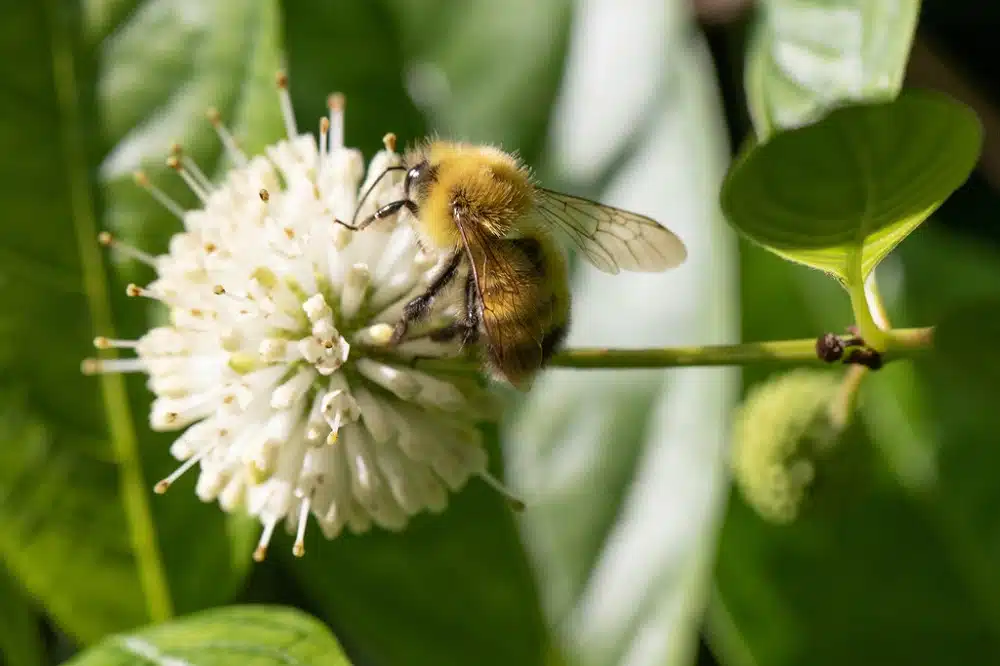
Native to North America, Perplexing Bumble Bees (Bombus perplexus) are mostly spread throughout Canada.
It also lives in Eastern US habitats.
The species has yellow and black hairs with worker bees having a wider brightly-colored section compared to queen Perplexing Bumble Bees.
These types of bumble bees may also be found in wetlands, as opposed to other similar species.
You can also find Perplexing Bumble Bees around various dry habitats and woodlands.
24. Brown-winged Striped Sweat Bee

Brown-winged Striped Sweat Bees (Agapostemon splendens) are seen in multiple US regions, including Florida.
It has a long season in Florida which lasts until November.
These bees are slightly smaller than a few other sweat bees with an average size of around 10mm.
Males Brown-winged Striped Sweat Bees are slightly larger than females.
You can identify the species by its base metallic green color which is contrasted by vivid yellow-golden bands.
25. Carpenter-mimic Leafcutter Bee

These types of bees (Megachile xylocopoides) have a black color, mimicking carpenter bees.
Native to North America, the species has a long season expanding to November in Florida and up to September outside of the state.
Unlike many other bees, it gathers pollen on its abdomen rather than on its legs.
Pollen is used to feed its young.
Carpenter-mimic leafcutter bees are solitary. Each female builds a small individual nest for eggs and provisions the emerging bees with pollen.
26. Half-black Bumble Bee

Asters and goldenrod next to woodlands are a common sight for these bees (Bombus vagans).
Half-black Bumble Bees are often seen in woodlands where they use trees for shade.
All types of other plants such as asters and clovers provision food for these bees.
Eastern parts of North America and the woodlands in this region are known to be the main habitats of the species.
Digging nests in the ground, these bees are further known for their solitary lifestyles and their combination of yellow and black hairs on the body and the face.
27. Red-belted Bumble Bee

An additional red color to the basic black and yellow color combination of bumble bees inspires the name of this species (Bombus rufocinctus).
A North American native, the bumble bee has a black and yellow thorax with a red, black, and yellow-banded abdomen.
Northwestern territories are the US home of the species.
These types of bees are easily spotted since they live in urban areas and since they nest on trees or in cavities, but not in the ground.
Strawberries tend to attract these bees early in the summer, together with vetches, clovers, and other plants.
28. Metallic Epauletted-Sweat Bee

A metallic green color on the head, thorax, and abdomen is specific to the female Metallic Epauletted-Sweat Bee (Augochloropsis metallica).
Eastern and Northeastern US states are known habitats for the species.
This species has a maximum size of 9mm and is contrasted by smoky tan wings.
It uses nest sites above the ground and visits multiple types of flowers.
Goldenrod and marigolds are among the most common flowers the species visits.
29. Sculptured Resin Bee

These black and yellow bees (Megachile sculpturalis) have been introduced to North America from Asia.
The species is seen in many habitats carpenter bees live in as they repurpose old wooden nests.
While they do not bore into wood themselves, Sculptured Resin Bees rely on wood for nesting.
They use resin, small wood fibers, and mud to line the nests and prepare them for laying eggs.
An imported status also means these bees are larger than many other native bees as they grow to 25mm.
30. Lemon Cuckoo-Bumble Bee

Native to Eastern and Northeastern US states, this species (Bombus citrinus) is also seen across Eastern Canada.
It represents one of the most common invasive species of the Common Eastern Bumble Bee.
The invasive Lemon Cuckoo-Bumble Bee kills the host nest queen.
The invasive queen achieves this by taking on the chemical cues of the hose queen to enter the nest.
Asters are among the most common pollen sources for Lemon Cuckoo-Bumble Bees.
31. Unequal Cellophane Bee

You can find these bees in various North American habitats including woodlands and riparian zones.
The species (Colletes inaequalis) feeds on a variety of trees and plants in parks as well.
Willows are among its most common hosts. This species is also seen on different other trees such as plums and maples.
You can often find them nesting right next to the trees they pollinate.
In-ground nesting is specific to the Unequal Cellophane Bee.
These bees nest in an area facing South so they get plenty of sun exposure both in the morning and in the afternoon.
32. Flat-tailed Leaf-cutter Bee
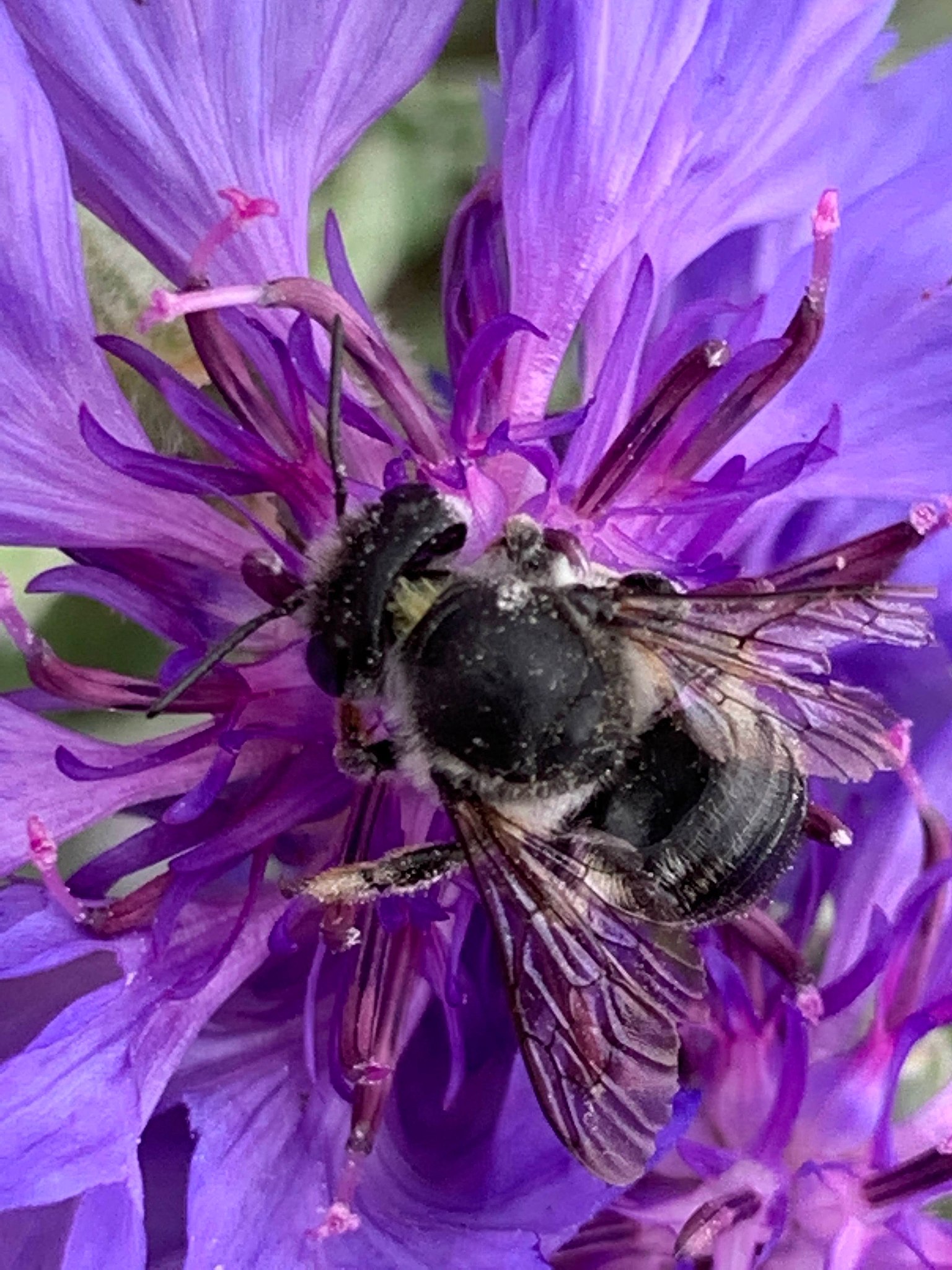
Flat-tailed Leaf-cutter Bees (Megachile mendica) are native to Eastern parts of North America.
This is a species with an expansive habitat with a few reports of the bees on The West Coast.
Common buttonbush is one of the plants this species helps pollinate.
Its flight season depends on its location but the bee is active almost all year in Southern states.
It’s identified by a mostly black body with a banded abdomen.
33. Orange-legged Furrow Bee

A black abdomen and a yellow-orange and black thorax characterize the species (Halictus rubicundus). The species also has orange legs.
Orange-legged Furrow Bees live both in colonies and on their own. Solitary behavior is more specific at high altitudes, areas naturally encouraging remote nesting.
These bees nest in the ground, next to plants and rocks, preferably in loose soil.
New nests are dug next to native nests within this species.
Orange-legged Furrow Bees are the most common in temperate regions of the world.
34. Western Carpenter Bee
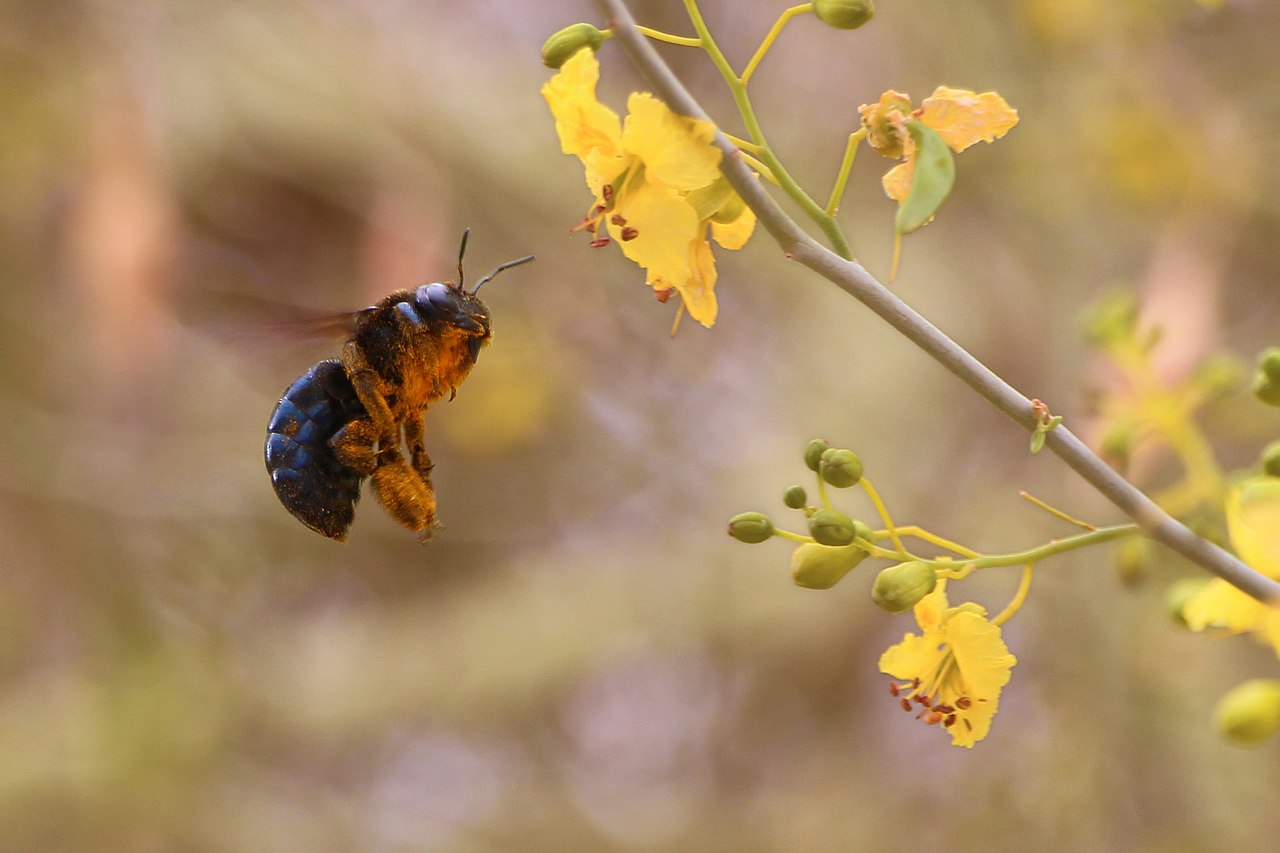
This black bee (Xylocopa californica) is common in California and across Western North America.
Its range expands to Utah and Washington in the North and to Texas and Arizona in the South.
It can be seen on flowers in the cooler times of hot summer days. A preference for pollen collection before noon is specific to its Southern habitat.
Small differences are noted between the male and the female Western Carpenter Bees.
Some parts of the body, such as the head, tend to be larger in females. Coloration is less diverse on female Western Carpenter Bees as they tend to have more black hairs than males.
35. Fuzzy-Horned Bumble Bee

This type of bee (Bombus mixtus) is native to the US and Canada.
A fuzzy black and golden-yellow color are specific to the species which also has black hairless legs.
Bees of the family are known for preferring high-altitude terrains. It’s at a higher elevation that they get to find some of their favorite plants and flowers to feed on.
Fireweed and rhododendron are among the high-elevation flowers it visits.
This species can be found on slopes and open fields up on mountains.
36. Texas Striped Sweat Bee

Identifiable by its metallic green thorax, the Texas Striped Sweat Bee (Agapostemon texanus) is a Southern species active until October.
Its habitat expands up to Canada and Central America. Its season only lasts until September in the North.
Texas Striped Sweat Bees quickly located locations for individual nests.
These can be trees or other man-made structures as well as nests in the ground.
It prefers to nest above the ground to stay clear from many types of predators which include flies and spiders.
37. Poey’s Furrow Bee

Active from February, this Eastern North American bee (Halictus poeyi) remains a visible species up to November.
It has a black and yellow color and a very long flight season for North American bees.
The species has a widespread presence in Central America s well.
Feeding on multiple types of pollen, Poey’s Furrow Bee has distinct smoky brown wings.
Very small differences between males and females are noted for the species. Males have bright antennae and a similar body size to female Poey’s Furrow Bees.
38. California Bumble Bee

This black and yellow species (Bombus californicus) is a common sight across California and a diminishing population species elsewhere.
It has alternating black and yellow bands of hair and smoky brown wings.
The California Bumble Bee is seen as a beneficial species through its role in crop, fruit, and flower pollination.
While a general pollinator, the California Bumble Bee is mostly a pollinator of blueberries, clover, and sage.
It emerges in the spring when the queen establishes a nest until July, at the latest.
Bees of the family remain active only until early September.
39. Rusty-patched Bumble Bee

These furry bees (Bombus affinis) are only found in the Northeastern parts of North America.
As one of the most beneficial bees in this part of the continent, the Rusty-patched Bumble Bee is facing a diminishing habitat.
It nests in wet or dry grounds and its overwinters are high elevation or on dunes.
This species is a known pollinator of tens of crops, including those onions.
Fruits such as cranberries and apples are also commonly pollinated by the Rusty-patched Bumble Bee.
40. Oblong Woolcarder Bee

This yellow and black bee (Anthidium oblongatum) is native to Europe and Asia with an introduced status in North America.
Eastern US states are the home of the species.
These bees live in all types of areas including human settlements where they use homes as nests.
The Oblong Woolcarder Bee uses cavities and crevices as a nesting site. Looking for very small openings, the species repurposes natural cavities as nests.
Pollen preferences are very specific for these bees. They only pollinate pea family plants such as stonecrop.
Gardens with pea legumes are among the most common homes for the species.
41. Oblique Longhorn

Oblique Longhorn bees (Svastra obliqua) are native to Southern parts of North America and Central America.
These bees represent a solitary species with the capacity of using a large nest together, at times.
Some male Oblique Longhorns are often found sharing their nests.
Differences between males and females are mostly small, and sometimes difficult to spot.
The length of the antennae is one of the few visible differences between the sexes. Male Oblique Longhorns have longer antennae.
42. Golden Sweat Bee

Golden Sweat Bees (Augochlorella aurata) have a distinct metallic green color. Males and females are highly similar in coloring and size.
This species grows to a maximum size of 7mm and it can be found in Eastern parts of Canada and Eastern US states.
In-ground social nesting is specific to the species.
A queen lays eggs that hatch into helping females at the beginning of the summer. Eggs and then laid for another brood which turns into male bees at the end of the summer or the beginning of the fall.
Some female bees of the species may decide not to follow the queen. In rare instances, some female Golden Sweat Bee break away from the group becoming solitary nesting bees.
43. Yellow-Fronted Bumble Bee

This species of bee (Bombus flavifrons) lives across high-elevation plains in North America, up to Alaska.
Yellow-fronted Bumble Bees are a large species growing to 12mm and 19mm as queen bees.
A queen bee establishes the nest at the end of March. Only queens and new queens overwinter while worker females and male bees die at the end of the summer.
You can find Yellow-Fronted Bumble Bees on all types of high-elevation flowers such as asters and mint.
This species is subject to parasitism by cuckoo bees.
44. Modest Masked Bee

These bees (Hylaeus modestus) are named after the large yellow mark on their faces.
The rest of the body and their legs are black.
A native North American species, the Modest Masked Bee has a widespread presence on the West Coast, on the East Coast, and in Northern territories up to Alaska.
It feeds on some of the most common plants of the continent such as milkweed and goldenrod.
45. Nevada Bumble Bee

Nevada Bumble Bees (Bombus nevadensis) are some of the largest native bees in North America. The species grows to a size between 15 and 20mm.
Even worker bees can reach a length of up to 17mm.
The black and yellow species are seen on various prairies and fields where they feed on a thistle, salvia, clover, and sage.
46. Urbane Digger Bee
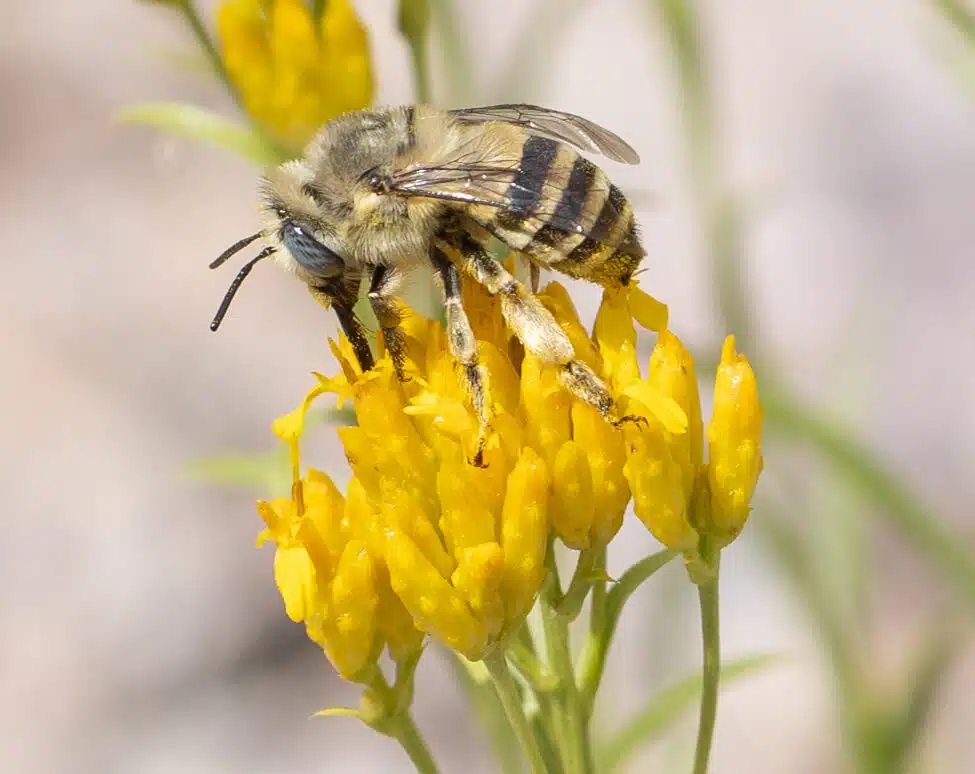
Urbane Digger Bees (Anthophora urbana) have a black and white abdomen and a yellow hairy thorax.
These bees are commonly seen in gardens and they’re among the most common species in urban settlements.
They nest in the ground, close to their plants of choice.
Each nest is close to another one. Males are seen patrolling these nests looking for females.
47. Pruinose Squash Bee

This bee (Peponapis pruinosa) is a common sight on crops as it only feeds on cultivars.
It prefers pumpkin and squash which it pollinates completely. Pruinose Squash Bees are as efficient at squash pollination as honeybees.
They nest in the ground, on the crop, or next to the crop as they aren’t interested in other types of flowers or plants.
48. Northern Amber Bumble Bee

North American woodlands are the primary home of the Northern Amber Bumble Bee (Bombus borealis).
This species has dark yellow and black hairs that cover its body.
An important pollination role has been attributed to these bees. Blackberries and common vetches are among their commonly pollinated species.
49. Hibiscus Turret Bee
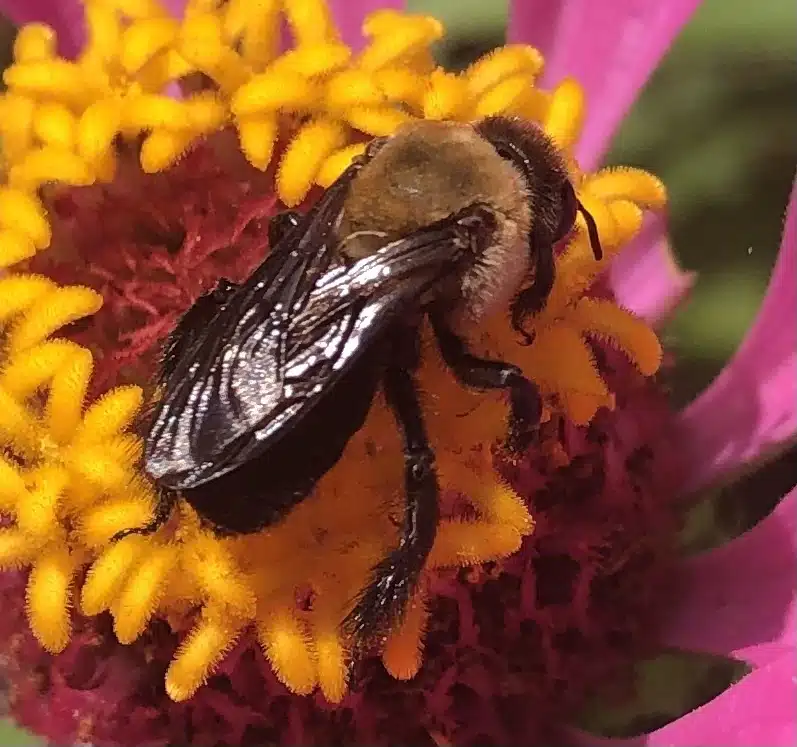
Hibiscus Turret Bees (Ptilothrix bombiformis) are seen around various species of hibiscus.
The bees nest in the ground, close to their pollinating flowers. Clear ground and loose soil is preferred by these bees.
A yellow hairy thorax and a hairless black abdomen are specific to the Hibiscus Turret Bee.
50. Yellow-banded Bumble Bee

These types of bees (Bombus terricola) live eusocially under a queen. The queen establishes a colony in the spring, soon after overwintering.
Nests are made in the ground for the emerging Yellow-banded Bumble Bees.
The species is seen as a beneficial type of bee with a positive role in natural crop pollination. These bees also pollinate plants and flowers outside crops.
51. Confusing Furrow Bee

These types of bees (Halictus confusus) are common in North America. They nest in the ground with basic social communication.
A queen and her female followers lead the colony.
Most Confusing Furrow Bees prefer sandy terrains for their nests. Some exceptions are seen across Europe.
This bee species forage asters such as heath asters.
52. California Digger Bee
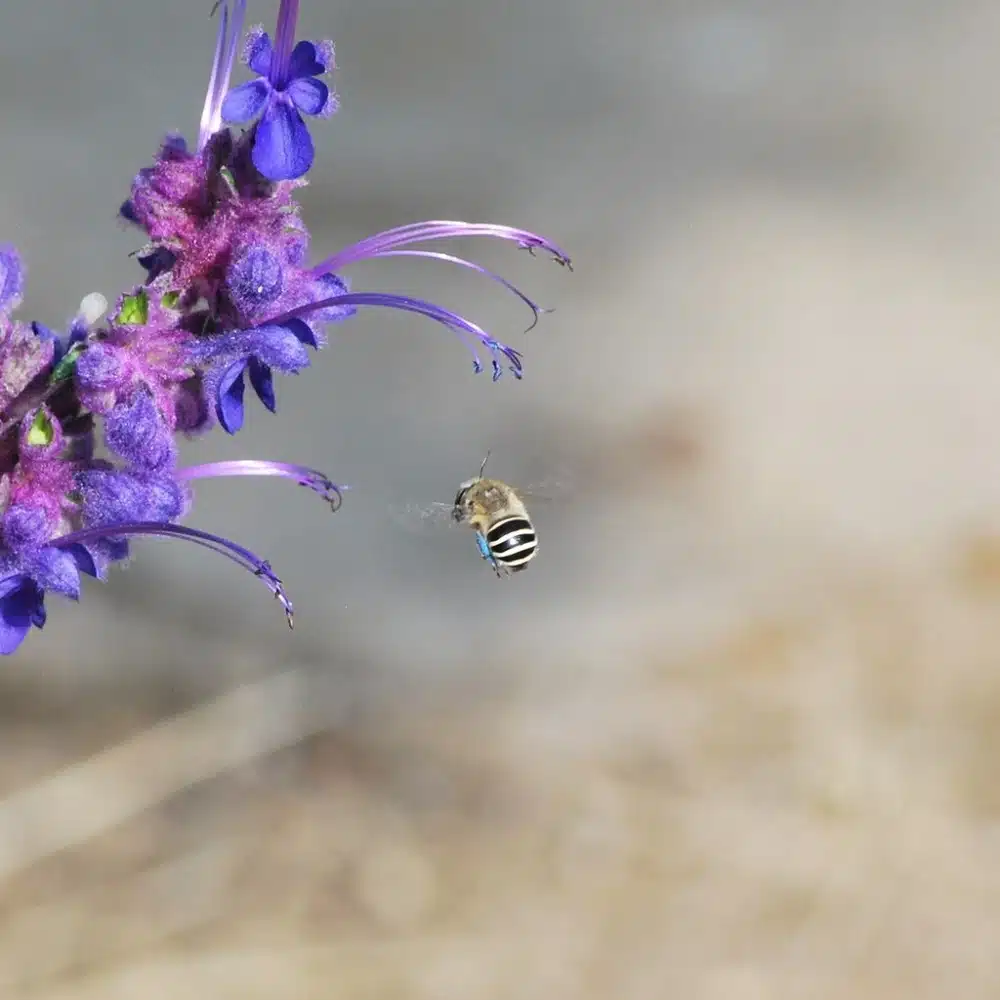
These bees (Anthophora californica) are native to California, as their name implies.
In-ground nesting is specific to the species.
You can identify these bees by a hairless black and white banded abdomen and by their hairy yellow-orange thorax.
Multiple grouped ground-level nests are seen hosting California Digger Bees.
53. Alfalfa Leafcutter Bee

This type of bee (Megachile rotundata) has an introduced status in North America.
Colonies were established to help pollinate crops.
Alfalfa Leafcutter bees nest in wood or the ground. They use leaves to line the nests and are a common sight on alfalfa and rapeseed crops.
54. Peridot Sweat Bee
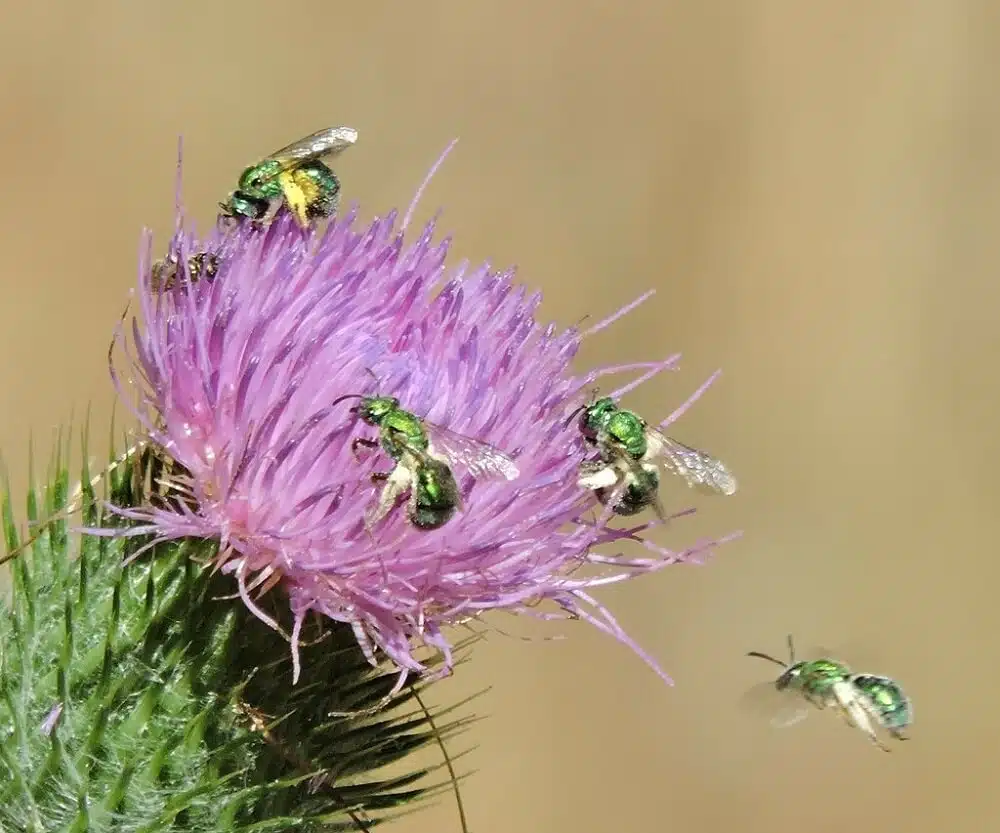
Peridot Sweat Bees (Augochlorella pomoniella) often land on people, just as other types of sweat bees.
This species is identified by a metallic green color with golden-yellow undertones. It has smoky wings that are slightly transparent.
Peridot Sweat Bees have a very long season with January being the only overwintering month of the species.
55. Western Leafcutter
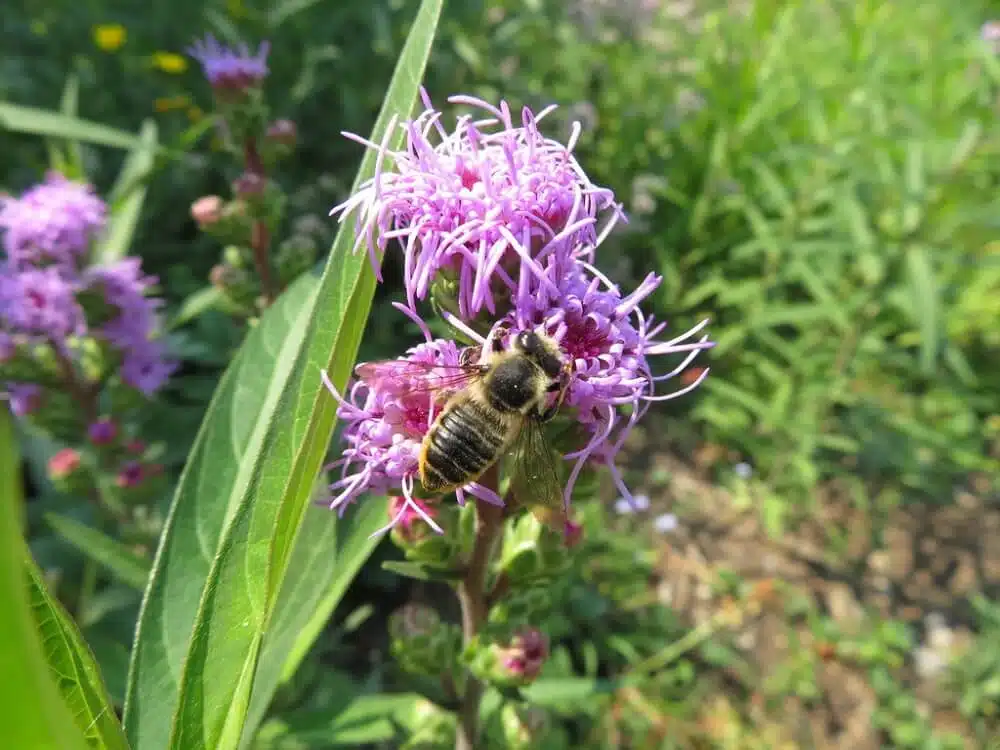
White, yellow, black, and brown and the main colors of the Western Leafcutter bee (Megachile perihirta).
The species is seen West of The Rocky Mountains and it builds nests in the ground or crevices.
It uses leaves to build nests that are rich with pollen and nectar for the young bees to feed on.
56. Wilke’s Mining Bee

Wilke’s Mining Bees (Andrena wilkella) are native to Europe with an introduced status in North America and Europe.
They can reach a maximum size of 12mm as females.
This type of bee is seen on bean family plants and other legumes.
Clovers are a common foraging sight for these bees.
The species can live individual lives or live together in shared nests or nests of proximity.
57. Blue Orchard Bee

Blue Orchard Bees (Osmia lignaria) are some of the most common native bees seen along fruit trees.
These bees have a black or gray-to-black color with a size that can reach up to 15mm.
A common sight around gardens, Blue Orchard Bees are highly efficient at pollinating apple and cherry trees.
58. Horn-faced Mason Bee

Horned-faced Mason Bees (Osmia cornifrons) are native to Eastern Asia.
This species is common in Japan where it is economically used to pollinate apple trees. It has very high pollination rates as it visits thousands of apple tree flowers each day.
Bees of the species use existing cavities to nest individually or in small groups.
Holes in logs or bamboo are a common nesting site.
Each of these nests is then used by females to lay an egg.
59. Southern Plains Bumble Bee

These types of bees (Bombus fraternus) are a common sight in Texas.
As opportunistic nesters, they take advantage of cavities and pre-made holes for nesting.
Southern plains are the common habitat for the species which visits and pollinates milkweeds and bush clovers.
60. Blueberry Digger Bee
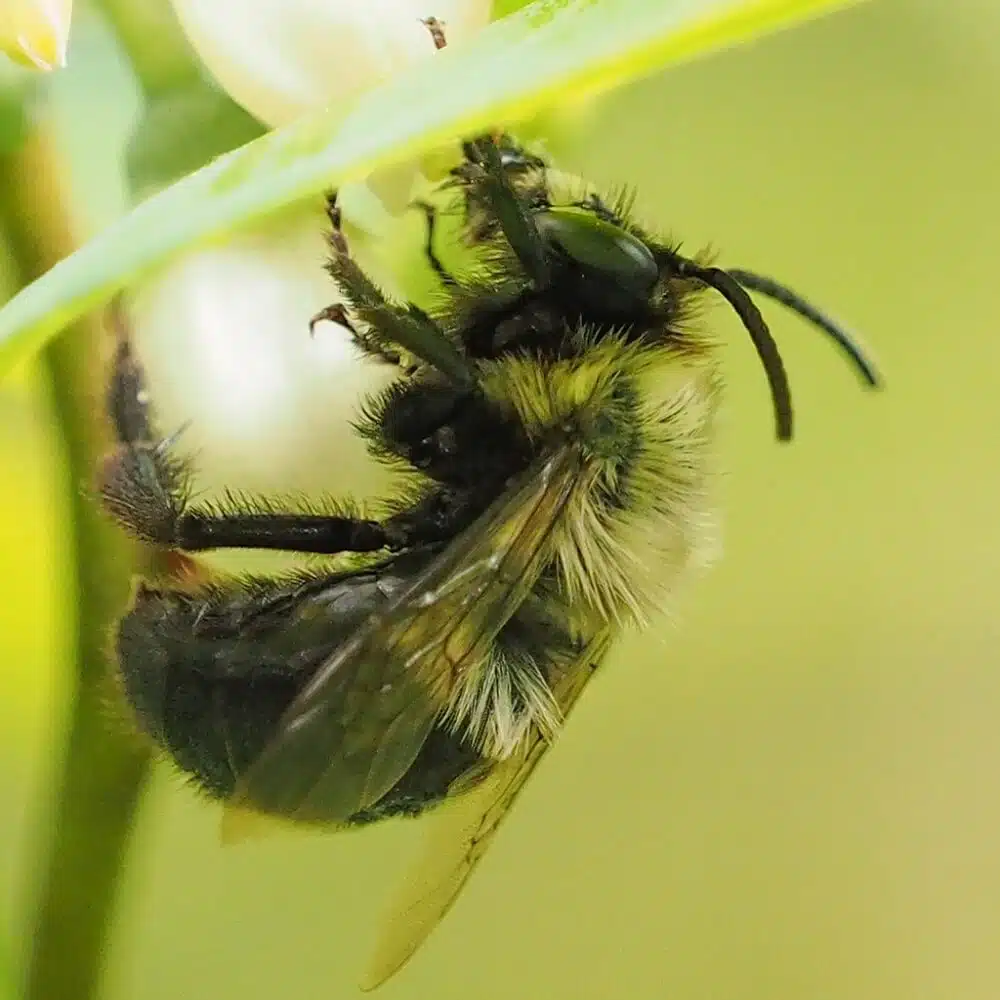
Dry and sometimes sandy soils are the perfect nesting habitat for the Blueberry Digger Bee (Habropoda laboriosa).
This Southern species has distinct traits which make it an important buzzing pollinator of blueberries.
Smaller than bumble bees, Blueberry Digger Bees are more efficient in all-day pollination, both in the case of males and females.